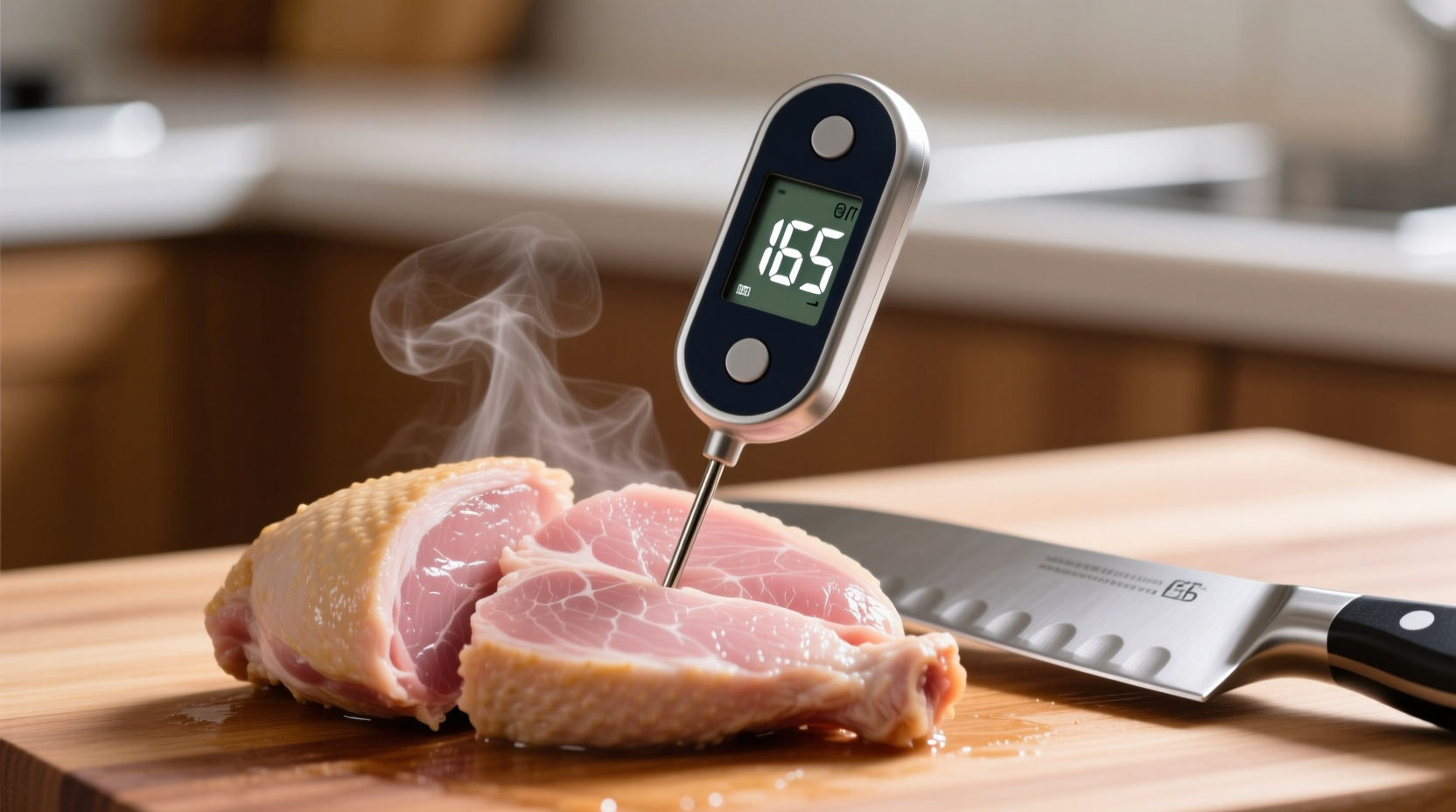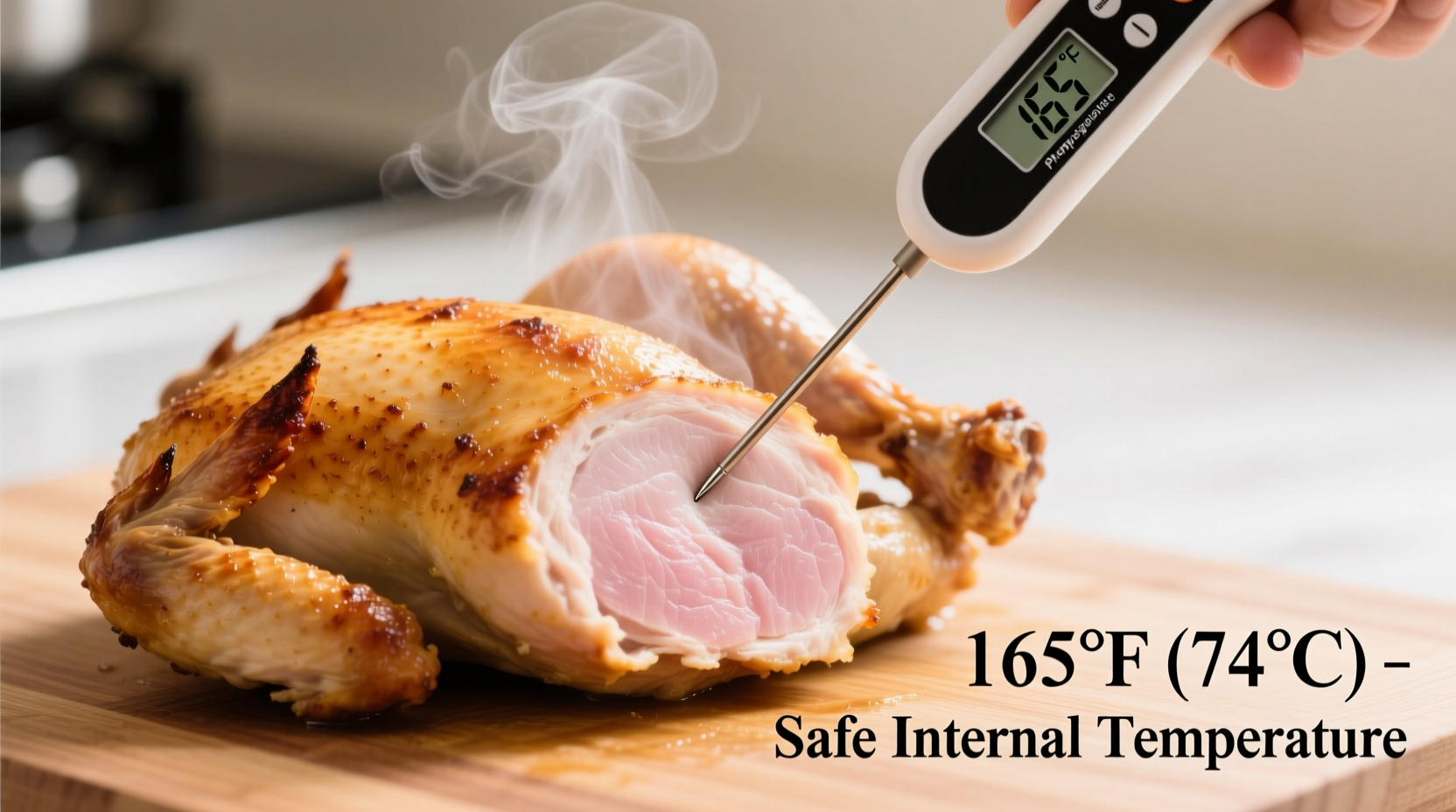Chicken must be cooked to a safe internal temperature of 165°F (73.9°C) according to USDA food safety guidelines. This temperature destroys harmful bacteria like salmonella and campylobacter, ensuring your poultry is safe to eat while maintaining optimal texture and moisture.
Getting chicken temperature right isn't just about safety—it's the difference between juicy, flavorful poultry and dry, potentially dangerous meat. As a home cook, understanding precise temperature requirements prevents foodborne illness while delivering restaurant-quality results every time. Let's explore exactly how to achieve perfect chicken, whether you're grilling, roasting, or pan-searing.
Why 165°F Is the Food Safety Standard
Chicken requires thorough cooking because raw poultry commonly contains pathogens that cause foodborne illness. The USDA's Food Safety and Inspection Service (FSIS) established 165°F as the minimum safe temperature after extensive research demonstrated this threshold reliably destroys Salmonella, Campylobacter, and other dangerous bacteria.
Unlike beef or pork, chicken's structure allows bacteria to penetrate deeper into the meat, making surface cooking insufficient. This is why color alone ("when the juices run clear") isn't a reliable indicator—scientific testing confirms pathogens can survive in seemingly cooked chicken.
| Chicken Cut | Recommended Temperature | Resting Time | Special Considerations |
|---|---|---|---|
| Whole Chicken | 165°F (73.9°C) | 15-20 minutes | Check thickest parts of breast and thigh |
| Chicken Breast | 160-162°F (71-72°C) | 5-10 minutes | Remove at 160°F; carries over to 165°F |
| Thighs/Drumsticks | 170-175°F (77-79°C) | 5-10 minutes | Darker meat tolerates higher temps |
| Ground Chicken | 165°F (73.9°C) | 3-5 minutes | No carryover cooking; eat immediately |
How to Measure Chicken Temperature Correctly
Using a reliable instant-read thermometer properly is essential. Insert the probe into the thickest part of the meat, avoiding bones, fat, or gristle which give false readings. For whole birds, check both breast and thigh areas.
Many home cooks make the critical error of checking temperature too early. Wait until the chicken appears nearly done before testing, as frequent opening of ovens or grill lids causes significant temperature fluctuations. Digital thermometers with probes that remain in the meat during cooking provide the most accurate continuous monitoring.

Understanding Temperature Context Boundaries
While 165°F remains the universal safety standard, cooking professionals often use nuanced approaches based on cut and cooking method:
- White meat (breasts) becomes dry above 162°F due to low fat content. Remove breasts at 160°F and let carryover cooking reach 165°F during resting.
- Dark meat (thighs, drumsticks) contains more connective tissue requiring higher temperatures (170-175°F) to become tender without drying.
- Sous vide cooking allows precise temperature control at lower temperatures (145-150°F) for extended periods, but requires strict time controls to ensure safety.
- Smoking chicken at low temperatures (225-250°F) still requires final internal temperature of 165°F for safety.
The FDA Food Code consistently reaffirms 165°F as the critical control point for poultry safety across all commercial foodservice operations. This standard appears in the 2022 FDA Food Code and the USDA's Safe Minimum Cooking Temperatures guidelines.
Avoiding Common Temperature Mistakes
Even experienced cooks make these temperature errors:
- Trusting color over thermometer - Chicken can appear white yet still harbor pathogens
- Testing too early - Opening oven/grill frequently drops cooking temperature
- Misplaced thermometer - Checking near bone gives falsely high reading
- Skipping resting time - Prevents carryover cooking from reaching safe temp
- Using inaccurate thermometers - Calibrate regularly with ice water test
For perfect results, remove chicken breasts when they reach 160°F and let rest for 5-10 minutes. During this time, residual heat will carry the temperature to the safe 165°F mark while allowing juices to redistribute—critical for moist, tender meat.
When Visual Cues Support Temperature Readings
While thermometers provide definitive safety verification, these visual indicators confirm proper cooking when combined with temperature checks:
- Juices run clear (not pink) when pierced
- Meat separates easily from bone
- Texture is firm yet yielding to touch
- Internal color is white throughout (no translucent areas)
Remember: These visual cues alone aren't sufficient for food safety. Always verify with a thermometer, especially for thicker cuts where exterior appearance may deceive.
Troubleshooting Temperature Issues
Undercooked chicken (below 165°F): Return to heat immediately. For oven-roasted birds, tent with foil to prevent exterior burning while interior reaches temperature. For grilled pieces, move to indirect heat zone.
Overcooked chicken (above 175°F for breasts): While safety isn't compromised, texture suffers. Rescue dry chicken by slicing against the grain and serving with sauce or broth. For future cooking, remove breasts at 160°F and allow carryover cooking during resting.











 浙公网安备
33010002000092号
浙公网安备
33010002000092号 浙B2-20120091-4
浙B2-20120091-4